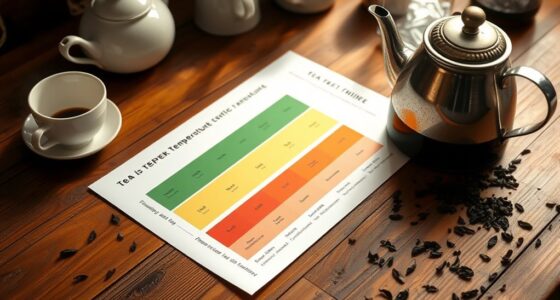Many beginners skip proper milk steaming, which is crucial for creating smooth microfoam for latte art. Using the wrong milk or overheating it can ruin textures and shine. Pour too fast or too slow, and your designs will blur or be incomplete. It’s essential to master simple shapes first and pay attention to cup fill levels and pour height. Neglecting equipment cleanliness also leads to poor results. Keep these basics in mind, and you’ll improve faster than you think — more tips await.
Key Takeaways
- Overheating milk destroys texture and shine, leading to poor microfoam essential for latte art.
- Pouring too fast or from too high causes splashing, breaking crema, and uneven patterns.
- Neglecting equipment cleaning results in clogged wands, poor foam quality, and flavor issues.
- Filling cups improperly—either over or under—makes creating clean, consistent designs difficult.
- Inconsistent pouring speed and height hinder control, causing blurred or incomplete latte art shapes.
Skipping Proper Milk Steaming and Texturing

Skipping proper milk steaming and texturing is a common mistake that can ruin your latte art. Milk frothing is essential for creating the smooth, velvety microfoam needed for good designs. When you skip this step or rush through it, your milk won’t have the right consistency. Focus on proper texturing techniques—angle the pitcher, keep the steam wand just below the surface, and swirl gently—to develop a shiny, silky foam. Avoid overheating the milk, which can break down the texture. Mastering milk frothing takes practice, but it’s vital for achieving the perfect canvas for your latte art. Without proper milk steaming and texturing, your designs may look flat or bubbly, making it impossible to create those intricate patterns you’re aiming for. Additionally, understanding the importance of microfoam can significantly improve your results.
Using the Wrong Milk or Temperature

Using the wrong type of milk or setting the temperature too high can considerably hinder your latte art efforts. Milk selection impacts how well your milk froths and pours; whole milk generally yields the best microfoam, while alternative milks may require adjustments. Temperature control is equally essential—overheating causes loss of sweetness and poor texture, reducing your chances of creating smooth, glossy designs. To help you choose wisely, consider this table:
| Milk Type | Best Use |
|---|---|
| Whole Milk | Creamy, stable microfoam |
| Skim Milk | Froths quickly but less rich |
| Almond Milk | Light, requires careful steaming |
| Oat Milk | Good texture, versatile |
Proper milk selection and precise temperature control are key to successful latte art.
Pouring Too Fast or Too Slow

Pouring your milk at the right speed is essential for creating clean, well-defined latte art. If you pour too fast, the milk can break through the espresso crema, causing blurry designs and uneven contrast. Pouring too slow, on the other hand, may result in thin, weak patterns or incomplete shapes. Finding the correct pouring speed helps you control consistency, allowing the milk to flow smoothly and evenly into the cup. Practice maintaining a steady pour, adjusting your speed as needed to achieve the desired design. Remember, small adjustments make a big difference. Consistent control over your pouring speed guarantees sharper, more precise latte art, giving your designs a professional finish. Mastering this balance is key to improving your latte art skills. Controlling pouring speed is a fundamental technique that can significantly influence your overall results.
Not Practicing Basic Shapes Before Complex Designs

Jumping into complex designs without mastering basic shapes can make your latte art frustrating. Focus on simple forms first to build confidence and improve your technique. Avoid overcomplicating your designs until you’re comfortable with the fundamentals. Practicing layered textiles in your decor can also help you understand depth and contrast, which are essential skills for creating intricate latte art.
Master Simple Forms First
Focusing on simple shapes before attempting complex designs is essential for building your confidence and developing steady hand movements. Start with basic forms like hearts, rosettas, and tulips, which help you master foam consistency and cup selection. Using the right cup shape and size makes a difference—wider rims help control flow and detail. Consistent foam texture ensures smooth pours and clean lines. Here’s a quick visual guide:
| Shape | Foam Consistency | Cup Selection |
|---|---|---|
| Heart | Velvety, microfoam | Wide-mouthed |
| Rosetta | Smooth, glossy foam | Narrow, tall |
| Tulip | Firm, stable foam | Medium-sized |
Focusing on these fundamentals prepares you for more complex designs later on. Additionally, understanding the importance of color accuracy in visual presentation can help you improve the overall aesthetic of your latte art.
Build Confidence Gradually
After mastering simple shapes, it might be tempting to jump straight into complex designs. However, building confidence gradually is key to long-term success. Focus on making incremental progress with each attempt, celebrating small victories like perfecting a rosette or heart. This steady confidence growth helps you stay motivated and reduces frustration. Rushing into intricate patterns can overwhelm you and hinder skill development. Instead, practice consistently, refine your basic techniques, and trust that mastery comes with time. Each successful pour boosts your confidence, encouraging you to try new styles at a comfortable pace. Remember, patience and persistence are essential. By taking small steps forward, you’ll develop a solid foundation that makes tackling complex designs more manageable and enjoyable. Incorporating mindfulness practices during your practice sessions can also enhance focus and overall skill improvement.
Avoid Overcomplicating Designs
While it might be tempting to try complex latte art designs right away, skipping the practice of basic shapes can hinder your progress. Focusing on simple forms like hearts, rosettas, or tulips helps you master control over your pour and milk texture. Jumping into intricate creative patterns too soon often leads to overcomplicating your designs, making them look messy or uneven. Instead, perfect these basics first, then gradually experiment with color blending to add flair. When you’re comfortable with simple shapes, you can layer different colors or shading techniques without losing clarity. Remember, building a strong foundation in basic shapes allows your designs to look cleaner and more impressive, giving you the confidence to explore more complex latte art over time. Additionally, practicing with Vetted equipment like the right milk frothing tools can significantly improve your technique and results.
Ignoring the Importance of Cup and Pouring Height

One common mistake beginners make is neglecting the significance of cup and pouring height, which can drastically affect the outcome of your latte art. Proper cup positioning ensures stability and a consistent pour, while paying attention to pouring height influences how the milk interacts with the espresso. If you pour from too high, the milk may splash or create uneven patterns; too low, and you risk disturbing the crema or overfilling. Keep the cup at a comfortable height—usually about 3-4 inches from the spout—and maintain a steady, controlled pour. Adjusting your pouring height helps control the flow and can make the difference between a messy pour and a clean, defined design. Mastering this balance is essential for improving your latte art skills. Additionally, understanding the impact of automation technology in various industries highlights how precision and consistency—similar to controlled pouring—are crucial for achieving professional results.
Overfilling or Underfilling the Cup

Properly filling your cup sets the stage for successful latte art. Overfilling or underfilling can ruin your design before you start. If your cup is overfilled, the foam will spill, making it hard to control your pour and resulting in messy art. Underfilling leaves too much space, causing uneven patterns and difficulty layering the milk. To get it right, pay attention to cup volume and practice pour control. Additionally, understanding the size and dimensions of your cup ensures the right fill level for optimal latte art.
- Use a measuring tool to fill to the right level
- Leave enough space for foam without overflowing
- Adjust your pour speed based on cup size
- Keep consistent pour height for better control
- Practice filling cups to develop muscle memory
Neglecting Cleanliness and Equipment Maintenance

Neglecting cleanliness and proper equipment care can seriously impact your latte art. Dirty tools make it harder to create smooth foam, while leftover milk residues can cause curdling. Skipping maintenance can also lead to equipment failures that disrupt your entire process. Regular cleaning and maintenance ensure consistent results and extend the lifespan of your equipment.
Dirty Equipment Hinders Foam
Dirty equipment and poor maintenance can substantially weaken the quality of your foam, making it difficult to create smooth, consistent latte art. When equipment isn’t kept clean, contaminant buildup occurs, which affects the steam quality and milk frothing ability. This leads to uneven, bubbly foam that’s hard to manipulate. Neglecting equipment hygiene causes residues that can alter the milk’s texture and flavor, ruining your presentation. Regularly cleaning your steam wand, pitcher, and espresso machine prevents these issues. Additionally, effective environmental interactions during cleaning help maintain optimal equipment performance and longevity.
- Build-up of mineral deposits and milk residues
- Reduced steam pressure and inconsistent frothing
- Bacteria growth affecting milk quality
- Poor heat transfer resulting in uneven foam
- Decreased lifespan of your equipment
Maintaining clean equipment ensures superior foam texture and consistency for better latte art results.
Residual Milk Causes Curdling
When leftover milk isn’t thoroughly cleaned from your equipment, it can lead to curdling in your latte. Milk residue builds up on steam wands, pitchers, and valves, creating an environment for bacteria and spoilage. Over time, this residue can cause curdling issues when you steam or pour milk, affecting both taste and appearance. Curdled milk results from improper heating or contaminated equipment, which alters the milk’s acidity and texture. To prevent this, always clean your tools after each use, ensuring all milk residue is removed. Regular maintenance removes potential sources of bacteria and guarantees your equipment functions properly. Proper cleaning not only helps avoid curdling but also maintains the quality of your latte art, giving you smooth, velvety milk every time.
Neglected Maintenance Affects Performance
Residual milk buildup isn’t the only factor that can compromise your latte art; neglecting regular maintenance and proper cleaning routines can also severely impact your equipment’s performance. Over time, dirt and residue clog your machine, reducing steam power and altering milk texture. This not only affects the quality of your latte art but also shortens your equipment’s longevity. Poor maintenance can lead to costly repairs or replacements. To keep your machine running smoothly, follow consistent cleaning routines and address issues promptly.
- Clogged steam wands and nozzles
- Mineral buildup in boilers
- Increased risk of bacterial growth
- Reduced heating efficiency
- Shortened equipment lifespan
Frequently Asked Questions
How Does Humidity Affect Milk Steaming Quality?
Humidity levels directly impact your milk steaming quality by affecting milk texture. When humidity is high, the milk tends to foam more easily, creating a smoother, creamier texture. Low humidity, however, can make it harder to achieve the desired microfoam and can cause your milk to become frothy or separated. To get the best latte art, monitor humidity and adjust your steaming technique accordingly for consistently perfect milk texture.
Can Different Coffee Beans Impact Latte Art Outcomes?
Sure, your latte art might look like abstract art if you choose the wrong coffee bean varieties or roast levels. Dark roasts can make the milk’s contrast pop, while lighter roasts offer more nuanced shades. Different coffee beans also influence crema quality and acidity, affecting how smoothly your milk flows. So yes, selecting the right bean and roast level can turn your latte art from a mess into a masterpiece—if you know how.
What’s the Ideal Cup Shape for Better Designs?
The ideal cup shape for better latte art is a wide, rounded cup with a narrow opening, allowing you to pour smoothly and control the flow. Keep your pouring angle steady and slightly inclined to direct the milk flow accurately. This combination helps create clean, crisp designs. A balanced cup shape and consistent pouring angle make it easier to achieve intricate patterns and improve your overall latte art skills.
Does the Type of Milk Foam Affect Pouring Techniques?
Yes, the type of milk foam directly impacts your pouring technique. When you get the milk consistency and foam texture right, pouring becomes smoother, allowing your designs to flow effortlessly. Thicker, microfoam holds its shape better, giving you more control, while frothier, less stable foam can be tricky. Pay attention to the foam texture, and you’ll find pouring becomes easier, making your latte art sharper and more consistent.
How Do I Fix Common Mistakes in Early Latte Art Attempts?
To fix common latte art mistakes, first check your milk temperature; it should be around 140-150°F for smooth pouring. Adjust your pitcher grip to maintain control and a steady pour. If your design isn’t forming, try pouring more slowly or from a slightly higher height. Practice consistently, and over time, you’ll improve your technique, making your latte art more precise and impressive.
Conclusion
Think of latte art like tending a delicate garden. With patience, proper care, and attention to detail, your designs will flourish. Skip the basics, and your creation may wither. But nurture your skills—practice steady pouring, keep your tools clean, and experiment gradually. Soon, your cups will bloom with beautiful patterns, turning every coffee into a work of art. With time and care, you’ll master this craft, making each cup a masterpiece.










